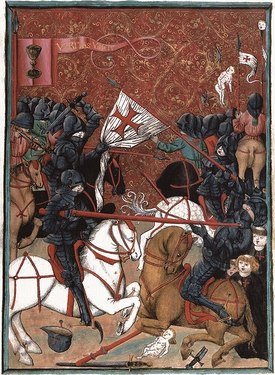
Back حروب الهوسيين Arabic حروب الهوسيين ARZ Guerres husitas AST Husçular hərəkatı Azerbaijani قوسچولار ساواشی AZB Гусіцкія войны Byelorussian Гусіцкія войны BE-X-OLD Хуситски войни Bulgarian Guerres hussites Catalan Husitské války Czech
This article includes a list of general references, but it lacks sufficient corresponding inline citations. (May 2018) |
The Hussite Wars, also called the Bohemian Wars or the Hussite Revolution, were a series of civil wars fought between the Hussites and the combined Catholic forces of Holy Roman Emperor Sigismund, the Papacy, and European monarchs loyal to the Catholic Church, as well as various Hussite factions. At a late stage of the conflict, the Utraquists changed sides in 1432 to fight alongside Roman Catholics and opposed the Taborites and other Hussite factions. These wars lasted from 1419 to approximately 1434.
The unrest began after pre-Protestant Christian reformer Jan Hus was executed by the Catholic Church in 1415 for heresy.[1][2] Because Sigismund had plans to be crowned the Holy Roman Emperor (requiring papal coronation), he suppressed the religion of the Hussites, yet it continued to spread.[3] When King Wenceslaus IV of Bohemia, brother of Sigismund, died of natural causes a few years later, the tension stemming from the Hussites grew stronger. In Prague and various other parts of Bohemia, the Catholic Germans living there were forced out.
Wenceslaus's brother, Sigismund, who had inherited the throne, was outraged by the spread of Hussitism.[3] He received permission from the pope to launch a crusade against the Hussites, and large numbers of crusaders came from all over Europe to fight. They made early advances, forcing the Hussites back and taking Prague. However, the Hussites reorganized and took back nearly all the land they had lost, resulting in the failure of the crusade.
After the reins of the Hussite army were handed over to yeoman Jan Žižka, internal strife followed. Seeing that the Hussites were weakened, the Germans undertook another crusade but were defeated by Žižka at the Battle of Německý Brod. Three more crusades were attempted by the papacy, but none achieved their objectives. The Lithuanians and Poles did not wish to attack the Czechs, Germany was having internal conflicts and could not muster up a sufficient force to battle the Hussites, and the king of Denmark left the Czech border to go back to his home. As the conflicts went on, the Hussites also made raids into German territory.
The wars eventually ended in 1434 when the moderate Utraquist faction of the Hussites defeated the radical Taborite faction. The Hussites agreed to submit to the authority of the king of Bohemia and the Roman Catholic Church and were allowed to practice their somewhat variant rite.
The Hussite community included much of the Czech population of the Kingdom of Bohemia and formed a major spontaneous military power. The Hussite Wars were notable for the extensive use of early handheld firearms such as hand cannons and of wagon forts by the Hussites.
Cite error: There are <ref group=lower-alpha> tags or {{efn}} templates on this page, but the references will not show without a {{reflist|group=lower-alpha}} template or {{notelist}} template (see the help page).
- ^ Kuhns, Oscar (1907). John Huss : The Witness. New York Public Library: Cincinnati : Jennings and Graham ; New York : Eaton and Mains.
- ^ Shahan, Thomas Joseph (1908). . Catholic Encyclopedia. Vol. 4.
- ^ a b Lützow, Francis (1914). The Hussite Wars. University of Toronto Library: London : Dent, New York : Dutton.
